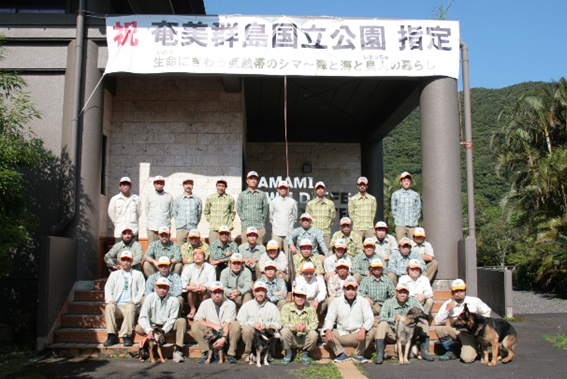Nature Wonder-Island Vol. 3 | The Current Conditions and Front-line Exterminators of Invasive Species
島コト
2019/02/08
奄美野生生物保護センター
‘Ugaminshouran’ (Hello)! I am Makino (surname) of the Amami Wildlife Center,
In this 3rd article, I’ll be introducing the invasive species on Amami and the exterminators on the frontlines.
Nature Wonder-Island Vol. 1- Why does so much rare wildlife remain on Amami?
Nature Wonder-Island Vol. 2 | What kind of place is the Mangroves?
Everyone, have you heard of the term ‘invasive species?’
An invasive species refers to a creature that came from another region by human activity to a specific region that the species did not inhabit originally. If you give Amami Oshima as an example, species like the Small Indian mongoose and the creeping-oxeye plant come to mind, as these two types of living creatures were brought from overseas.

The Small Indian mongoose, invasive species

The creeping-oxeye plant, invasive species
The opposite term to ‘invasive (or alien) species’ is ‘native species,’ which indicates that the species has originally inhabited a specific region. On Amami Oshima, the Amami rabbit, and the Amami-ebine (Calanthe amamiana) are native species.

Amami rabbit, native species

‘Amami-ebine’ (Calanthe amamiana), native species
What happens if there are invasive species on Amami Oshima? At a glance it seems likes these invasive species are unrelated to us, but they are actually a big problem. I’ll explain using the Small Indian mongoose and the creeping-oxeye plant as examples.
The Small Indian mongoose is an animal that eats plants as well as other animals. The Small Indian mongoose was originally brought to Amami Oshima for the purpose of exterminating the Habu snake, but contrary to people’s expectations, they have started to eat native species such as the Amami rabbit, not the Habu snake.

A Small Indian mongoose eating the Ryukyu green snake, a native species
In addition, the Small Indian mongoose has caused damage to crops in the past. It would be very troublesome if crops like vegetables and brown sugar (raw sugar cane) that should line our dinner tables were gone.
The creeping-oxeye plant is very tenacious, and its ability to adapt to its environment is very high. If it takes root in a place where a native plant is rooted, then it displaces the native species.
Furthermore, wildlife that relies on this native plant could be lost, and the entire landscape could completely change.

The creeping-oxeye plant that displaces native plants
These invasive species are troublesome if they spread on Amami Oshima… We cannot stand idly by and do nothing about invasive species that have spread. Next, I will explain the front lines of extermination!
In terms of exterminating the Small Indian mongoose, in 2005 the Ministry of the Environment launched a mongoose control project and formed the “Amami Mongoose-busters” for the purpose of completely eliminating the Small Indian mongoose from Amami Oshima.

The Amami Mongoose-busters
The Amami Mongoose-busters inspect the traps as well as carry out capture efforts with a mongoose search dog daily. Thanks to the work of the Amami Mongoose-busters, they’ve reduced the number of Small Indian mongoose that was estimated to be about 10,000 at times to less than 50. The good news is that accompanied by the decrease of Small Indian mongoose, the habitat expansion of native species on Amami Oshima has also been confirmed.

The trap inspection done by the Amami Mongoose-busters
Currently on Amami Oshima, the Amami Wildlife Center, cities and towns, local elementary and middle schools, everyone is working together to carry out exterminating the creeping-oxeye plant as well. Everyone is working to protect the natural landscape of Amami Oshima.

Effort to exterminate the creeping-oxeye plant
Although eliminating an invasive species that has taken hold is tough work, that which humans brought in must also be taken care of by humans.
Let’s all do our best to protect the nature and wildlife of Amami Oshima, as well as to create an Amami Oshima we can boast about to the world!
この記事を書いたフォトライター

奄美野生生物保護センター
奄美群島の自然や生き物に関する展示を行う環境省の施設。
野生生物の調査、外来種対策、自然観察会を通した普及啓発や世界自然遺産登録に向けた取組などを総合的に行う拠点にもなっている。
開館時間:午前9時30分~午後4時30分
休館日:毎週月曜日(祝日を除く)、年末年始(12月29日~1月3日)
住所:鹿児島県大島郡大和村思勝字腰ノ畑551番地
電話:0997-55-8620
管理協力: 鹿児島県自然保護課、奄美群島12市町村









